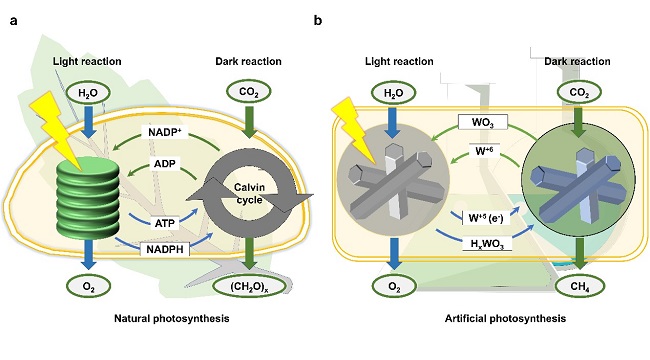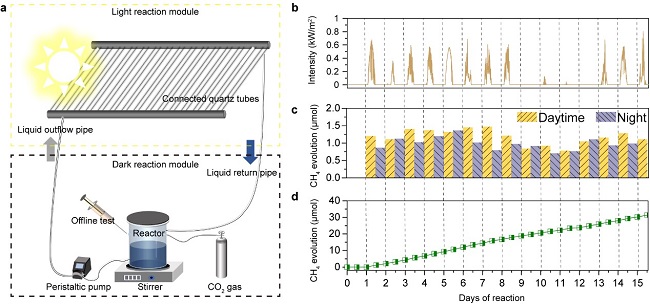All-weather Solar-driven CO2 Utilization by Mimicking Natural Photosynthesis Achieved
The development of technology for CO2 conversion into valuable products presents a significant opportunity for the coordinated development of our country's economy and ecological environment.
The CO2 conversion is a typical negentropy process that demands a substantial input of energy. Therefore, clean and renewable solar energy emerges is an ideal source.
Nonetheless, the reliance of the solar-powered CO2 transformation process on sunlight illumination is a limiting factor for its real-world implementation, given the intermittent availability of solar irradiance during night and on cloudy or rainy days. Additionally, the mismatch in timing between the availability of solar energy and the demand for its use, influenced by variations in daylight hours and meteorological conditions, presents a substantial challenge for the effective deployment of CO2 photoconversion. Consequently, the creation of a strategy that separates CO2 reduction from the constraints of solar energy availability is crucial for achieving continuous, all-weather CO2 conversion.
The Air Purification New Technology team (AirPNT) from the Institute of Earth Environment, Chinese Academy of Sciences (IEECAS) in collaboration with various domestic teams, employs the charge storage mechanism of tungsten-based nanomaterials for all-weather CO2 conversion.
They've designed a novel model material Pt-WO3 for decoupling light and dark reaction processes by mimicking natural photosynthesis (Fig. 1). The unique characteristics of the WO3 carrier, including its ability to alternate between valence states (W6+/W5+) and its tunnel structures—combined with Pt's proficiency in water splitting and transferring hydrogen atoms onto the h-WO3 surface, are the key to achieve the decoupling of light and dark reactions for CO2 conversion.
When exposed to simulated sunlight for 10 minutes, the catalyst proved its capability to sustain the conversion of CO2 to CH4 even in the dark, marking the inaugural instance of a single material achieving uninterrupted all-conditions CO2 conversion.
Building on this material's properties, the team also crafted an outdoor experimental equipment and conducted a 15-day continuous natural light test (Fig. 2). The data gathered from outdoor experimental equipment revealed that the CO2 reduction process could persist through the night and during rainy periods, showcasing a successful all-weather CO2 conversion through a renewable approach.
This research approach has the potential to overcome critical technological bottlenecks in achieving continuous solar-driven CO2 utilization.
This work, published in the National Science Review (NSR), was jointly funded by the Strategic Priority Research Program of the Chinese Academy of Sciences, China, the National Natural Science Foundation of China, and the Youth Cross Team Scientific Research Project of the Chinese Academy of Sciences.

Fig. 1 Schematic illustration of the decoupled light and dark reactions in the process of solar-driven CO2 reduction (Image by Shi, et al)

Fig. 2 Demonstration of solar-driven CO2 utilization application. (Image by Shi, et al)
Contact: Bai Jie, Institute of Earth Environment, Chinese Academy of Sciences, Xi'an, China. Email: baijie@ieecas.cn
 © 2015 Institute of Earth Environment,CAS
© 2015 Institute of Earth Environment,CAS Address:No. 97 Yanxiang Road, Xi'an 710061, Shaanxi, China

 Location :
Location :